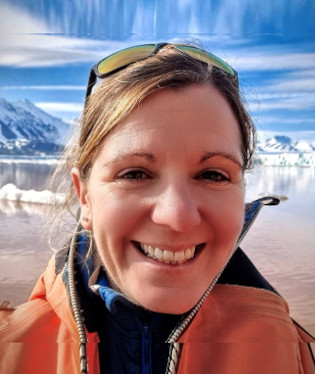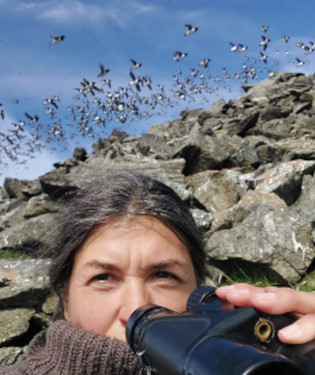Plenary speakers
| WELCOME ADRESS: Paulo Catry, MARE – Marine and Environmental Sciences Centre / ARNET - Aquatic Research Network, ISPA – Instituto Universitário, Lisboa, Portugal | |
 |
The wanderings of Cory’s shearwaters nesting on the Selvagens Islands Long before ecology existed as a science, people wondered about animal movements and the changes in their abundance. The Selvagens (meaning “wild”), part of the archipelago of Madeira (Portugal), are some of the most remote and seabird-rich islands in the northeast Atlantic. Here, since 2004, we have monitored population size and trends, and researched the behavioural ecology of Cory’s shearwaters Calonectris borealis, with a strong focus on spatial ecology. Over a period of 18 years, we have tracked the migratory movements of birds of all age classes, revealing a surprising diversity of strategies and a high level of individual variability that still defies our understanding. During this talk, I will discuss the intrinsic factors (age, sex, body condition) and extrinsic factors (winds) that drive such variability, and look at different correlates and consequences, including telomere dynamics, physiological condition, accumulation of pollutants and timing of migration. I also report the good news that the population is increasing and consider possible ways to monitor burrow and crevice-nesting seabirds, such as shearwaters, for which data on population trends are still remarkably scarce. |
| PLENARY SPEAKER 1: Samantha Patrick, University of Liverpool, UK | |
 |
Optimising movement decisions in a changing environment: what can we learn from seabirds? Phenotypic plasticity is often one of the first changes observed in response to environmental change. With many traits, individuals do not have control of the environment they experience, leaving changes in phenotype as their only option. Movement behaviours offer a rare opportunity where by individuals can change their behaviour in a given environment or move to a new environment. Adaptive changes in space use are well described by patch switching and habitat matching theory, but examining changes in spatial and non-spatial traits concurrently is essential. Seabirds are ideal model system to study these questions as their slow life-history limits the potential for rapid evolutionary change and their wide-ranging movements, which are well studied, offer ample opportunity to switch habitats. Foraging is a classic example of repeated movements over time and is fundamental to movements both within the breeding season and the winter period. Using evidence from a range of seabird species across the globe I will explore the evidence for plasticity in temporal and spatial foraging traits in changing environments. Finally, I will assess how evolution may act on plasticity in movement traits. This will combine research on the fitness consequences of movement behaviour and the heritability of different foraging parameters. By combining empirical and theoretical evidence, this talk aims to highlight the importance of combining habitat switching and plasticity in non-spatial traits for understanding plasticity in adaptive changes in movement in a changing environment. |
| PLENARY SPEAKER 2: Katarzyna Wojczulanis-Jakubas, University of Gdańsk, Poland | |
 |
Parental care: a challenge for seabird parents… and seabird researchers Seabirds have long been neglected in studies on parental care, and this is because studying their parental behaviour continues to be a challenge. Nevertheless, seabirds are truly devoted parents and offer an unusual perspective in the discussion on differences of male and female contribution into raising the offspring and evolutionary stability of the biparental care system. Focusing on a pelagic species, the little auk, and using long-term data collected in the system I will consider two issues related to parental behaviour: 1) parental labour division between the sexes– who, how much and why is involved into particular activities? and 2) coordination of parental performance between the breeding partners - how much the parents coordinate their activities and what are mechanisms behind the coordination? Considering the issues I will point out the challenges related to the investigation of parental behaviour in seabirds and will show some examples of possible solutions. |
| PLENARY SPEAKER 3: Jennifer Provencher, Environment and Climate Change, Canada | |
 |
Moving from examining conservation issues separately to considering cumulative effects; a case study of bringing it all together when assessing the threats to northern fulmars in the Canadian Arctic Seabird populations are under pressure from multiple threats; legacy contaminants, plastic pollution, emerging diseases, invasive species, oil spills, fisheries bycatch, etc. etc. etc. A species shown to be under multiple types of threats is the northern fulmar in Northern Canada. Contaminants have shown to be at some of the highest levels in this species in the region, with emerging chemicals of concern often detected in this group. Plastic pollution has been documented in fulmars at such high levels that they have been designated indicator species for plastic particles across their range in the North Atlantic. Oil pollution from increased vessel traffic is an emerging concern. At the same time bycatch of fulmars in gillnets used in the region have recently been shown to have potential population level impacts. These conservation concerns have been reported in Northern fulmars nesting in the Canadian Arctic Archipelago since the early 2000s, but almost exclusively as independent stressors. With fulmar populations in some regions of the Arctic showing a declining trend, there is an immediate need to work with a range of conservation tools in order to influence emerging policies and practices. To address concerns, and inform emerging policies, we employed a series of exercises that used expert opinion (both Indigenous and western-based knowledge) to assess both the threats, and their manageability to help direct conservation actions and prioritize research needs. By harnessing social science methods to an applied conservation challenge, we can better contextualise decades of work on seabird issues to better inform the complex policy landscape of multiple threats on seabird populations. |
